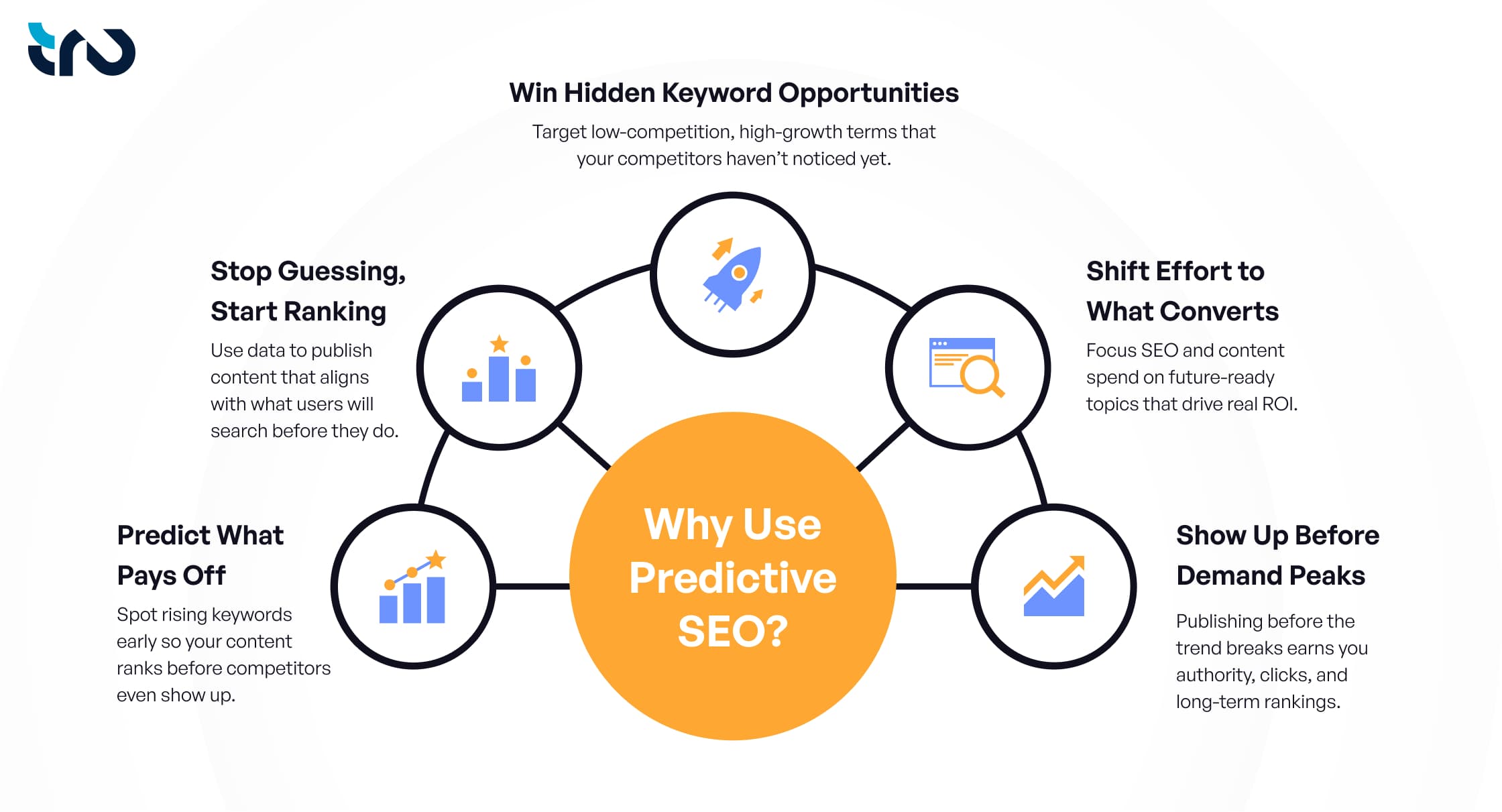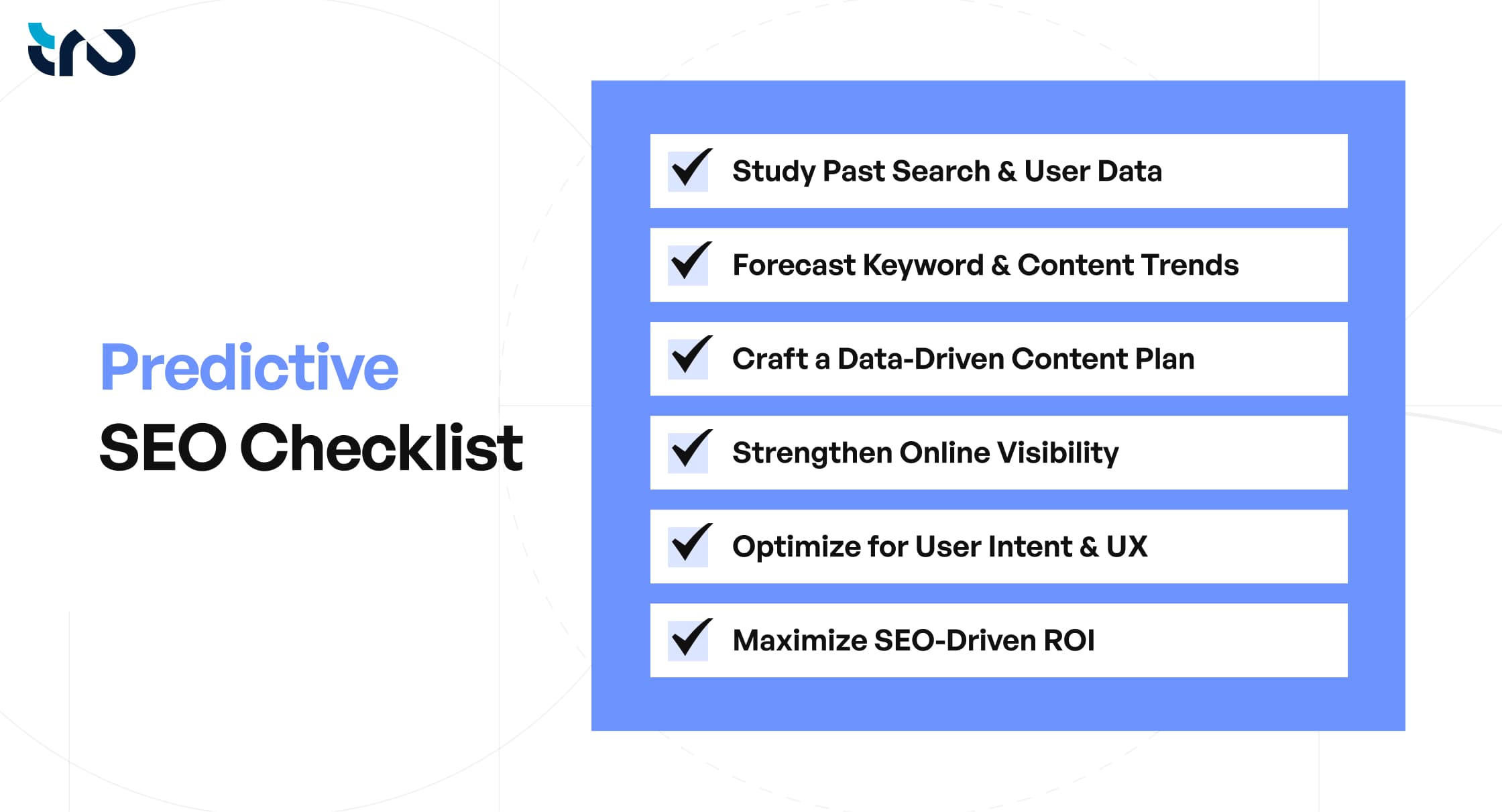According to Exploding Topics, over 13.6 billion searches happen on Google every single day. That’s billions of signals from users sharing a glimpse of their shifting demands.
With the rise of AI and a digital-first world, search behavior is evolving faster than ever. Trends come and go in days, not months, making it nearly impossible to track user shifts manually. This is why leading businesses are implementing “Predictive SEO.”
In this guide, we’ll break down the core components of Predictive SEO, its uses, and best implementation practices. Whether you’re scaling an SEO program or exploring new methods, you’ll walk away with clear, actionable insights.
What is Predictive SEO?
Predictive SEO is the process of using past data, analytics, and AI collectively to anticipate future search trends and user behaviour. Data that is studied includes website traffic, SERP performance, click patterns, and user journeys. This helps brands optimize content before demand peaks, not after.
The goal? Show up before your audience starts searching.
Core Components of Predictive SEO:
The table below represents the main pillars of the strategy:
S.No. | Components of Predictive SEO | Strategic Purpose | Tools Used |
|---|---|---|---|
1 | Forecasting SEO traffic | Estimating traffic you can expect from existing keywords/content. | SEOmonitor, GSC, Google Analytics |
2 | Predict future keyword trends | Identifying keywords that will gain popularity in the future. | Google Trends, Exploding Topics |
3 | Anticipate content demand shifts | Predicts content topic popularity and what audiences will search for. | BuzzSumo, MarketMuse |
4 | Identify high-opportunity areas with AI & data models | Holistically analyzing multiple signals (intent, SERP features, topic clusters, competitor gaps) | Clearscope, Surfer SEO, ChatGPT |
Why Use Predictive SEO?

1. Build Smarter, Data-Backed Content Calendars.
Predictive SEO helps businesses identify the content gaps and predict future traffic on keywords that may have lower search volumes right now. Thus, they can build a smarter calendar that boosts your brand’s online presence.
2. Target What Drives ROI.
When businesses analyze Google’s predictive search, SERP, and high-volume topic cluster, they can optimize the ad campaigns, as well as blog content, to get the best returns on investment.
3. Outrank Competitors Before They React.
When you forecast accurately, your brand shows up before search demand peaks—positioning you ahead of slower competitors and strengthening long-term visibility and trust.
At Tru, our digital marketing services are built to integrate smart strategies like predictive SEO. We help brands stay ahead of search trends and connect with users before the competition does.
Best Practices to Implement Predictive SEO

1. Analyze the past user and search data
Utilize machine learning algorithms to study large datasets of past SEO data like website traffic trends, keyword rankings, click-through rate (CTR), bounce rates, and user behaviour.
2. Use data to predict trends
Use predictive analytics to find out high-impact keywords, traffic spikes, and upcoming search patterns. This is to ensure your next content hits before the demand curves.
3. Build a future-ready content strategy
Building an effective content strategy is the most challenging part for brands. Predictive SEO helps you build a content strategy that’s one step ahead, so you publish when others are still planning.
4. Strategize the brand’s online presence
Having all the data and content forecasts at your fingertips. Businesses can now use it to create result-oriented off-page and on-page SEO & paid strategies.
5. Improve brand value & user experience
Predictive SEO helps your brand meet customers at the moment of need. This spreads a positive impact on the brand’s recognition, trust, and enhances user experience.
Outcome? Boost the ROI of Business
A data-driven strategy means you reach buyers faster, compete less, and earn more. Smart SEO isn't reactive, it’s predictive.
The more strategic your SEO, the more leads you generate, the more sales you close, and the better your ROI!
Explore Tru’s SEO and organic marketing services. Engineered to outsmart algorithms, attract intent, and turn visibility into real business growth.
Real World Examples of Businesses Using Predictive SEO
1. Bosch (Automobile & Tech)
Bosch implemented predictive SEO to analyze historical ads and search. They predicted which keywords and search queries would spike in the future and optimized their landing pages before Google results peaked.
2. Hubspot (Marketing Software)
HubSpot’s own marketing team implemented predictive SEO internally to protect blog traffic. They built an “At Risk” tool that tracks Google rankings for thousands of articles. When a post’s ranking trend looked like it was about to drop off page 1, the tool flags it before traffic is lost.
3. Walmart (Retail)
Walmart’s has rolled out an AI-driven “Content Decision Platform” to personalize content. It uses predictive analytics to forecast which content and products each customer will engage with. The system then tailors each shopper’s homepage accordingly.
Discover more about predictive SEO
Implementing Predictive SEO will be a must in the future as search behavior becomes increasingly dynamic and intent-driven. However, a one-size-fits-all model doesn't work. At Tru, we tailor smart, high-impact strategies like Micro-Moment Forecasting and Competitor Weak Signal Intercept to meet each client’s unique goals. They’re proactive systems built to detect emerging search intent and capitalize on it before the competition even notices. This level of precision gives our clients a sustainable edge in both visibility and conversion.



